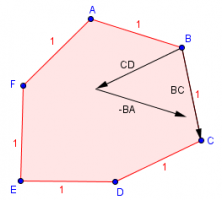MayaMaya121
New member
- Joined
- Jun 2, 2020
- Messages
- 15
Hi,
I have this question I'm currently stuck on about vectors, can anyone please help me?
Question:
There is given an equilateral hexagon ABCDEF (no drawing given and I already know that in an equilateral hexagon there are parallel sides).
prove:
[math]\overrightarrow{BC}=\overrightarrow{CD}-\overrightarrow{BA}[/math][math]\overrightarrow{AC}=2\overrightarrow{FE}-\overrightarrow{AF}[/math]
I have this question I'm currently stuck on about vectors, can anyone please help me?
Question:
There is given an equilateral hexagon ABCDEF (no drawing given and I already know that in an equilateral hexagon there are parallel sides).
prove:
[math]\overrightarrow{BC}=\overrightarrow{CD}-\overrightarrow{BA}[/math][math]\overrightarrow{AC}=2\overrightarrow{FE}-\overrightarrow{AF}[/math]

